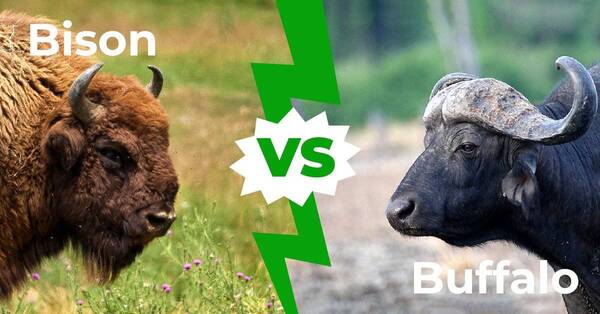When it comes to large, powerful herbivores, bison and buffalo often come to mind. Although they share similar habitats and appearances, these two animals are distinct species with unique characteristics. In this article, we’ll delve into the differences between bison and buffalo, comparing their physical traits, habitats, and behaviors, ultimately determining which one reigns supreme.

Scientific Name: Bison bison (American Bison)
Habitat: North America, primarily in plains and grasslands.
Population: Approximately 500,000 in North America, with conservation efforts increasing their numbers.
Scientific Name: Bubalus bubalis (Water Buffalo) and Syncerus caffer (African Buffalo)
Habitat: Water buffalo are found in Asia and parts of Europe, while African buffalo inhabit sub-Saharan Africa.
Population: Water buffalo populations exceed 200 million, while African buffalo are estimated at about 900,000.
Here’s a detailed comparison of bison and buffalo, highlighting their differences and similarities:
| Feature | Bison | Buffalo |
|---|---|---|
| Species | American Bison | Water Buffalo / African Buffalo |
| Size | Up to 6.5 feet tall and 2,000 pounds | Up to 5.5 feet tall and 2,600 pounds |
| Horns | Short, curved horns | Long, curved horns |
| Fur | Thick, shaggy coat | Shorter, sleeker coat |
| Behavior | More aggressive and territorial | Generally calmer, especially water buffalo |
| Social Structure | Form large herds, matriarchal groups | Social animals but less structured |
| Diet | Primarily grass and forage | Grasses, water plants, and crops |
| Conservation Status | Near threatened | Water buffalo are domesticated; African buffalo are vulnerable |
Buffalo generally outweigh bison, especially water buffalo, which can reach up to 2,600 pounds. However, bison are more muscular and stocky, giving them immense strength for their size. In terms of height, bison can reach about 6.5 feet at the shoulder, making them taller than buffalo, which average around 5.5 feet.
Bison have short, curved horns that can grow up to 2 feet long, while buffalo possess longer, more pronounced horns that can reach 3 feet. The shape and structure of their horns contribute to their ability to defend themselves against predators.
Bison are known for their more aggressive behavior and territorial nature, particularly during mating season. They are capable of charging at high speeds when threatened. On the other hand, buffalo tend to be more docile, especially water buffalo, which have been domesticated and are often used as working animals.
Bison form large herds led by a matriarch, exhibiting strong social bonds within their groups. Buffalo also live in herds, but their social structures are less hierarchical. African buffalo are known to be highly social and often form large, mixed herds.
When determining which animal is “stronger,” it largely depends on the context. If we consider size and weight, the buffalo may take the lead. However, in terms of muscularity, aggression, and the ability to fend off predators, the bison holds its ground. Both animals are remarkable in their own right, adapted to their environments and playing crucial roles in their ecosystems.
Ultimately, whether you prefer the imposing presence of the bison or the robust strength of the buffalo, both creatures represent the raw power and beauty of the animal kingdom. Understanding their differences not only enriches our knowledge of wildlife but also highlights the importance of conservation efforts for both species.
We created this article in conjunction with AI technology, then made sure it was fact-checked and edited by a Animals Top editor.